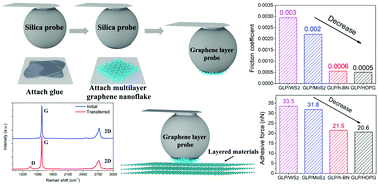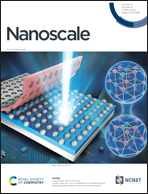Fabrication of a graphene layer probe to measure force interactions in layered heterojunctions†
Abstract
Layered heterojunctions have been widely used as two-dimensional (2D) semiconductors with unique electronic and optical properties recently. However, the force interactions in layered heterojunctions have been seldom studied. In this study, we propose a simple method to fabricate a graphene layer probe (GLP) to measure the force interactions in layered heterojunctions by atomic force microscope (AFM). The graphene layer probe was formed by attaching a multilayer graphene nanoflake onto a silica microsphere that had been glued to the AFM cantilever under an optical microscope. The frictional, normal, and adhesive forces between the graphene layer probe and four different 2D layered materials (HOPG, h-BN, MoS2, and WS2) were measured. Superlubricity was achieved at these layered heterojunctions with friction coefficients varying from 0.0005 (GLP/HOPG) to 0.003 (GLP/WS2). The variations of friction, adhesion, and van der Waals (vdW) interaction were consistent with the variations of the interlayer shear stress, the surface energy of the composed 2D layered materials, and the Hamaker constant of the heterojunctions, respectively. The good agreement between the measurements and theories confirms that this method is reliable for the fabrication of graphene or other 2D layered material probes and can be widely used for layered heterojunction measurements.



 Please wait while we load your content...
Please wait while we load your content...